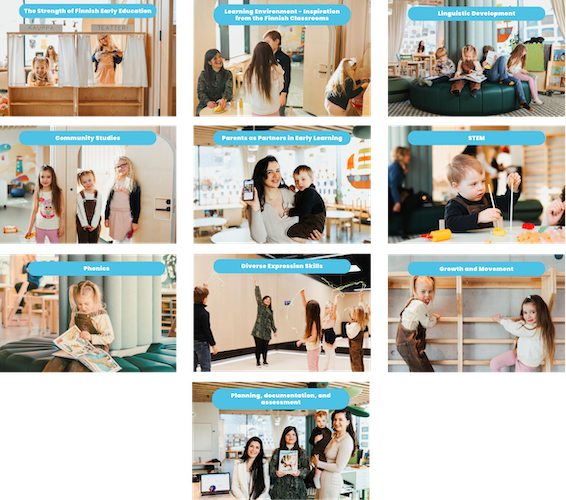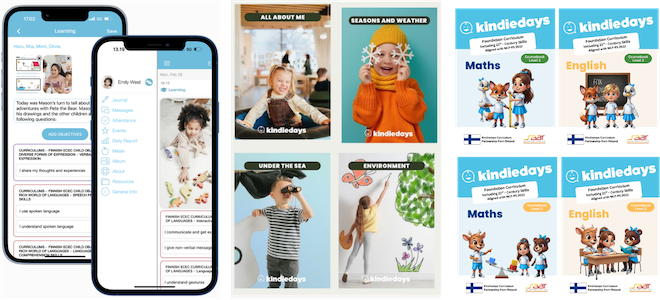Part 7 of 7
If you have followed our six-part blog series on "How to Set Up a Preschool" with Senior Preschool Consultant Ranjan Goyal, you now know what it takes to get started — from infrastructure and staffing to licensing and admissions. But once your preschool is up and running, the next big question arises:
How do you ensure your preschool stands out — offering visible quality that parents trust, teachers enjoy, and that keeps your classrooms full?
That’s where a Curriculum Partnership comes in.
The curriculum is not just a set of books — it’s the heart of your brand, your learning experience, and your parent-engagement strategy. For a challenger preschool with ambitions to grow, choosing the right curriculum partner can be one of the most critical business decisions you make.
This article will show you why, and — most importantly — how to select the best one for your school.

Why a Curriculum Partner Matters
Most mid-income city preschools today face three ongoing challenges:
- Teachers struggle to plan, document, and assess learning consistently.
Without structured lesson plans and modern tools, teachers spend hours preparing activities, leaving less time for interaction with children. - Parents demand visible learning results.
Families want to see their child’s progress, not just receive verbal updates. They expect stories, photos, and learning portfolios that demonstrate their child is making progress. - Competition keeps growing.
New preschools open every term, all promising “international” or “activity-based” learning. It’s hard to differentiate unless you have a recognised framework behind you.
A strong curriculum partner solves all three — offering:
- A ready-to-use, high-quality curriculum aligned with international best practices (like Finland’s play-based pedagogy) but adapted for Indian classrooms.
- Teacher training and ongoing support so your staff are confident, motivated, and consistent.
- Digital tools to document learning, build portfolios, assess learning, and share updates with parents in real-time.
- Marketing and parent-engagement materials that communicate quality clearly to families.
In short, a curriculum partner gives you both academic excellence and business advantage.
How to Choose the Right Curriculum Partner: A Practical Checklist
When evaluating options, look beyond flashy brochures. Use the following six lenses to identify a partner that genuinely fits your preschool’s needs and scale.
1. Alignment with Your Vision and Market Positioning
You serve aspirational, mid-income urban parents — those who seek a modern, high-quality experience that remains affordable.
Ask yourself:
- Does the partner’s educational philosophy match your goals? (Play-based? Holistic? 21st-century skills? Academic skills such as numeracy and literacy? )
- Is the curriculum adapted to India’s context (aligned with the NCF and NEP 2022) yet inspired by world-leading practices, such as Finland’s approach?
- Can the partner help you define a clear market identity, e.g., “Finland-inspired experiential preschool for holistic learning”?
When parents sense that your preschool follows a researched and globally recognised curriculum, they trust you more — and that trust translates directly into admissions.
2. Teacher Training and Ongoing Support
For example, in a 200-seat preschool, you’ll typically have 10–15 teachers and helpers. Keeping their teaching consistent and inspired is critical.
A good partner doesn’t just drop off a set of lesson plans — they walk with you.
Look for partners who:
- Provide interactive workshops for your teachers (both at the start and throughout the year).
- Offer mentoring to support teachers' professional growth.
- Include reflection tools and teacher-sharing communities for continuous improvement.
Your teachers are your brand ambassadors. When they are confident, parents notice — and recommend you.

Read more about the crucial role of the teachers.
3. Curriculum Content and Digital Tools
High-quality curriculum partners provide a complete package, not a patchwork of worksheets.
Check that the partner offers:
- Comprehensive, theme-based experiential lesson plans and coursebooks for ages 1–6, covering early literacy, numeracy, social-emotional learning, and motor skills.
- A digital tool or app that allows teachers and center heads to:
- Define and follow learning goals easily
- Capture learning moments with photos/videos
- Build individual child portfolios automatically
- Share updates with parents through a secure channel
- Secure quality using versatile statistics and reports
In a challenger preschool, efficiency is key. Digital tools reduce manual paperwork and ensure that every teacher — whether new or experienced — delivers a consistent, high-quality experience.

4. Parent Engagement and Evidence of Learning
In mid-income urban communities, parents often choose schools that show visible progress and frequent communication.
Ask if your potential partner provides:
- Parent-orientation materials — presentations, flyers, WhatsApp-friendly visuals — to explain the learning approach.
- Parent-engagement features — digital portfolios, regular stories of learning, progress updates.
- Support for two-way communication — so parents can respond and feel involved in their child’s growth.
When parents receive a steady stream of genuine learning updates, they develop trust. That trust keeps children enrolled for longer and attracts new families through word of mouth.

Read more about engaging parents.
5. Growth, Branding, and Operations Support
A strong curriculum partner supports your entire preschool journey — not just education.
Evaluate whether the partner helps you:
- Strengthen your branding as a quality, research-based preschool.
- Plan marketing activities (open houses, WhatsApp campaigns, social media posts).
- Implement systematic quality assurance.
In a challenger preschool, the difference between 70% and 90% occupancy can significantly impact profitability. A curriculum partner that drives visibility and trust helps fill those last seats.
.png)
6. Practical Factors: Cost, Scale, Localisation
Finally, look at the operational realities:
- Pricing model — Is it per-child, per-centre, or subscription-based? Ensure it scales as you grow.
- Local alignment — Are materials mapped to Indian frameworks (NCF, NEP)? Is the language and cultural context appropriate for your teachers and parents?
- Flexibility — Can you start small (for one centre) and expand later?
- Support — Does the partner assist in onboarding new teachers and periodic quality reviews?
For mid-income city preschools, affordability and sustainability are key considerations. Choose a partner that scales with you, not one that locks you into a heavy upfront cost.
Sample Comparison Matrix
| Selection criteria | Partner A | Partner B | Partner C |
|---|---|---|---|
| Pedagogical alignment | |||
| Teacher training & support | |||
| Curriculum materials & tools | |||
| Parent-engagement features | |||
| Marketing & Operations Support | |||
| Cost and scalability | |||
| Total |
Use this as a quick visual when you meet potential partners — it helps you see which one truly covers your preschool’s needs holistically.
Implementation: How to Introduce Your Curriculum Partner Successfully
Even the best partnerships need a thoughtful rollout. Here’s a 3-phase plan that works well for challenger schools:
Phase 1: Launch and Training (Months 1–2)
- Introduce the partner to your leadership and teaching teams.
- Conduct initial teacher workshops.
- Set up digital tools for lesson planning and documentation.
- Hold parent-orientation sessions to communicate your new approach and build excitement.
Phase 2: Classroom Integration (Months 3–6)
- Begin weekly theme-based implementation.
- Encourage teachers to document and share learning moments.
- Monitor adoption and hold peer-sharing sessions.
- Track parent engagement (feedback, portfolio views, testimonials).
Phase 3: Growth and Quality Review (Month 7 onwards)
- Utilize learning portfolios and stories for social media marketing.
- Conduct periodic quality reviews with your partner.
- Offer refresher training and recognise your best teachers.
- Expand your admissions drive using visible results and parent recommendations.
This cycle ensures that your partnership delivers measurable value — not just in academics, but in enrolment growth and parent satisfaction.
Final Thoughts
For a challenger preschool, the choice of curriculum partner shapes your school’s entire future.
The right partner will help you:
✅ Deliver consistent, joyful learning in every classroom
✅ Empower your teachers and reduce burnout
✅ Build parent trust through visible evidence of learning
✅ Strengthen your brand and admissions pipeline
✅ Achieve sustainable growth year after year
In a market where parents have many options but little time to research deeply, visible quality wins.
A strong curriculum partner gives your preschool that visibility — combining global best practices, teacher empowerment, parent engagement, and a scalable system that fits your size and budget.
If you are planning to upgrade your curriculum or launch a new preschool, now is the perfect time to explore how a Curriculum Partnership can transform your operations and help you achieve your long-term goals.
What next?
👉 Learn more about how Kindiedays can support your preschool with a complete Curriculum Partnership — combining Finnish early education principles, digital tools, lesson plans, and teacher workshops tailored for challenger preschools.

👉 Click here to schedule a consultative call on Zoom or contact me on WhatsApp!
I look forward to meeting you.
Milla van der Burgh
PS Meet us at the DIDAC conference from November 18th to 20th in Delhi.
--------------------------------------------------------------------------------------------------------------------
Kindiedays blog series to start a preschool
If you’ve been following our blog series, you now have a complete toolkit:
Part 1: How to Set Up a Preschool?
Part 2: Business Plan for a Premium Preschool in India
Part 3: Action Plan for Launching Your Preschool for Next Term
Part 4: How Visionary Owners Are Leading the Change
Part 5: Change Management Process
Part 6: Quality Assured Learning - The Competitive Edge
Part 7: How to Select a Curriculum Partner for Your Preschool
Many thanks to Ranjan for sharing his experience!
.png)